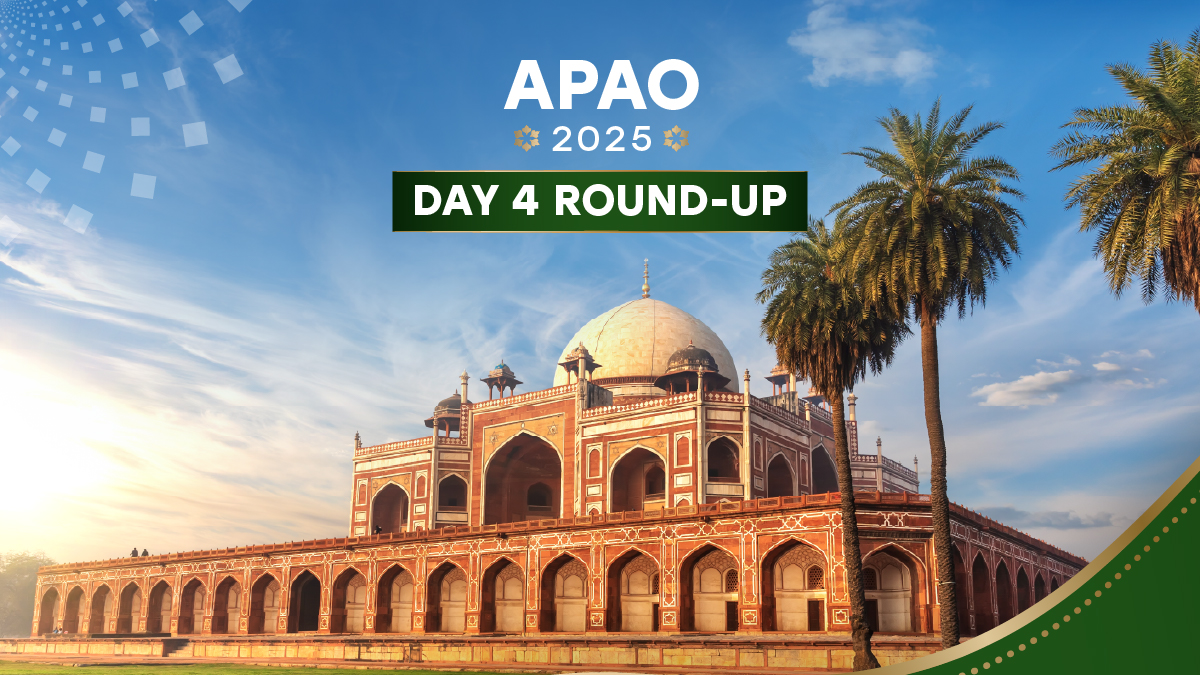AI, translational cornea innovations and surgical breakthroughs shined on Day 4 at APAO-AIOC 2025 as the conference wrapped up a visionary conference with a visionary last day.
As the curtains close on the ophthalmology world’s premier Asia-Pacific gathering, we look back at the four days that brought cutting-edge innovation, heated debates and a glimpse into eye care’s future.
The final day of the 40th Congress of the Asia-Pacific Academy of Ophthalmology (APAO 2025)—held in conjunction with the 83rd Annual Conference of the All India Ophthalmological Society (AIOC 2025)—wrapped up what has been, by all accounts, a spectacular convergence of ophthalmology’s brightest minds.
As delegates packed their bags and exhibitors dismantled their booths at the Yashobhoomi Convention Centre in Delhi, the buzz of new ideas and connections still lingered in the air.
Day 4 highlights: Surgical mastery and AI breakthroughs
The conference’s last day delivered quality over quantity, with three standout sessions that left attendees with plenty to ponder on their journeys home.
In a masterclass on retinal detachment techniques, eight global experts shared invaluable pearls for improving surgical outcomes in challenging cases. Dr. Philip Ferrone (USA) made waves advocating for methotrexate in pediatric cases with proliferative vitreoretinopathy, reporting an impressive 80% single-operation success rate.
Meanwhile, Dr. Ling Kiet Phang (Malaysia) discussed evolving silicone oil options, suggesting that while traditional options remain viable, exciting alternatives like hydrogen-based tamponades are on the horizon.
This is just a taste of what the symposium was all about, so check out the full write up now!
READ MORE: Latest Techniques for Retinal Detachment Success From APAO 2025
Over in a key AI glaucoma symposium, the focus shifted to how machine learning and advanced imaging might address a harsh reality where glaucoma is on the rise, and the workforce to treat it isn’t keeping pace.
Dr. Benjamin Xu’s (United States) ATLAS initiative has demonstrated how AI models can match or exceed human performance in detecting referable glaucoma from fundus photos.
Prof. Christopher Leung (Hong Kong) introduced ROTA (Regular Nerve Fiber Layer Optical Texture Analysis), a technique that outperforms conventional OCT analysis by combining thickness and reflectance information.
For more on how the world’s hottest technology is transforming glaucoma, check out the other talks on our future with the machines below.
READ MORE: AI, Imaging and the Glaucoma Crunch at APAO 2025: Can Tech Close the Gap?
A Day 3 session that was too good to not report on in anterior segment translational research rounds out our final edition, with discussions on corneal regeneration advances, personalized eye health mapping, and innovative drug delivery systems for dry eye and allergic conditions.
READ MORE: From Research to Reality: The Corneal Innovations at APAO 2025 Poised to Transform Ophthalmology
Your favorite APAO-AIOC 2025 articles
Throughout the four-day conference, certain topics captured your attention more than others—and if you missed them, now’s your chance to catch up with what over 10,000 ophthalmologists from around the world are reading about.
The APAO Award Lectures topped the charts, particularly Prof. Charles McGhee’s (New Zealand) Jose Rizal Medal Lecture challenging conventional wisdom on keratoconus with his “two-hit hypothesis” and Prof. Daniel Ting’s (Singapore) inaugural Dennis Lam Lecture on AI’s transformative role in ophthalmology.
READ MORE: APAO 2025 Award Lectures: 170 Years of Keratoconus and the Future of AI in Ophthalmology
A session on presbyopia correction proved to be another crowd-pleaser, with experts debating the merits of various approaches. Dr. Naren Shetty (India) championed refractive EDOF IOLs for their quality of vision, while Dr. Vaishali Vasavada (India) made a compelling case for trifocals. Dr. David Chang (USA) offered his “surf and turf” mix-and-match approach, and Dr. Helena Prior Filipe (Portugal) wowed the audience with a live IOL simulation tool that lets patients “test drive” their vision before surgery.
READ MORE: Presbyopia on the Table: What Works, What’s Next—Live from APAO 2025
Medical retina controversies also drew significant interest, as experts tackled thorny issues like red light therapy safety in myopia control, the gap between clinical trial results and real-world outcomes in AMD treatment, and the emerging recognition of non-exudative choroidal neovascularization as a distinct entity.
READ MORE: The Hottest Controversies in Medical Retina, Explained, at APAO 2025
Industry makes moves in India
The industry side of APAO-AIOC 2025 saw several significant product launches targeting the massive Indian eye care market.
- Johnson & Johnson Vision officially launched their TECNIS PureSee in India (with the help of your correspondent on the mic!), adding to their premium IOL portfolio in one of the world’s fastest-growing markets.
- Bausch + Lomb introduced their SeeLuma digital ophthalmic surgery visualization platform to India.
- Rayner made a splash with the Indian debut of their RayOne Galaxy IOL—the world’s first spiral IOL designed with AI.
The 2025 conference showcased not just the cutting edge of ophthalmology today, but the trajectory of eye care’s future—where AI assistance, personalized approaches, and innovative surgical visualization tools are becoming not just nice-to-haves, but essential components of modern practice.
And with that, it’s a wrap here in Delhi! We’ll be seeing you VERY soon for live coverage of the 2025 Annual Meeting of the American Society of Cataract and Refractive Surgeons (April 25-28), so stay tuned to our socials for the latest from Los Angeles.
Editor’s Note: Reporting for this story took place during the 40th Congress of the Asia-Pacific Academy of Ophthalmology (APAO 2025), being held in conjunction with the 83rd Annual Conference of the All India Ophthalmological Society (AIOC 2025) from 3-6 April in New Delhi, India.
